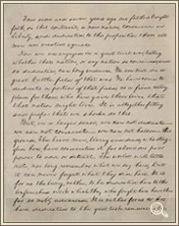

The Gettysburg Address Manuscripts
There are five known copies of the Gettysburg Address written in Abraham Lincoln’s hand. Over time each version has been named after the man who obtained the copy. Each has minor differences, as Lincoln refined the speech every time he reproduced it. The four other existing copies are:
Abraham Lincoln with his two personal secretaries, John Nicolay and John Hay. Photograph courtesy of Abraham Lincoln Presidential Library and Museum.
Nicolay Copy
Believed to be the earliest surviving draft of the speech, the opening page is written on White House stationery and the second page on lined paper. Historians believe that Lincoln began work on the speech in Washington and finished the text while in Gettysburg.
John Nicolay, one of Lincoln’s personal secretaries, was responsible for the president’s papers and this copy remained in his possession until he died in 1901. All of Nicolay’s presidential papers were then given to John Hay, Lincoln’s other secretary, for safekeeping.
Hay Copy
Lincoln wrote out the entire speech a second time on the same lined paper as the last page of the Nicolay copy and, according to the Hay family, presented that copy to John Hay. The manuscript remained largely unknown in Hay’s papers until 1909, when it was first published. In 1916 the Hay family donated both the Nicolay copy and the Hay copy to the Library of Congress.
Everett Copy
In 1864 Edward Everett, who had delivered the main oration at the Gettysburg dedication, asked Lincoln for a written copy of the speech. The draft was to be sold to raise money for the Union cause at the New York Sanitary Fair. The copy remained in private hands until it was given to the Illinois State Historical Library in 1943.
Bancroft Copy
Noted historian George Bancroft made a request for a copy on behalf of his stepson Alexander Bliss who was publishing a volume of manuscripts from the country’s leading writers to be sold at the 1864 Baltimore Sanitary Fair.
Lincoln initially wrote the text using both sides of the paper. However, the copying process the lithographer used required one side of the page to be blank. Bancroft wrote explaining the problem, and Lincoln produced the version that is now on display in this gallery. Bancroft was given the unusable draft. After passing through other owners, it was donated to Cornell University in 1949.

